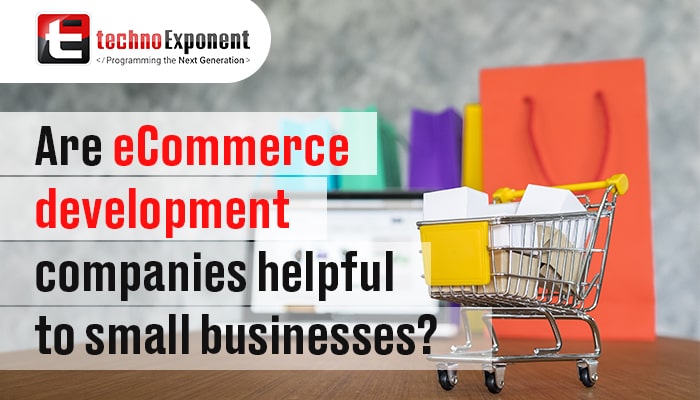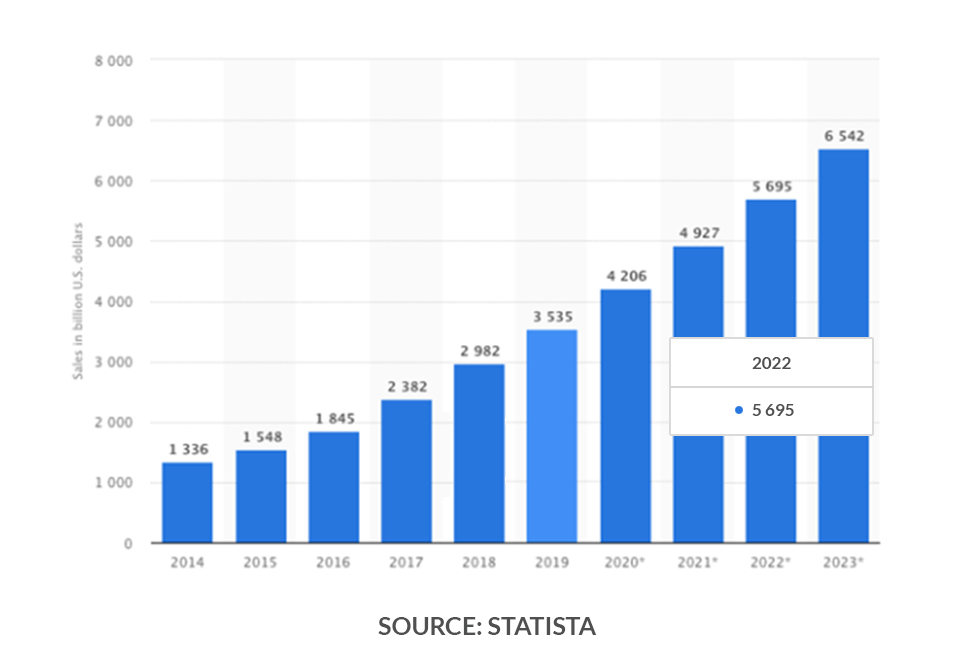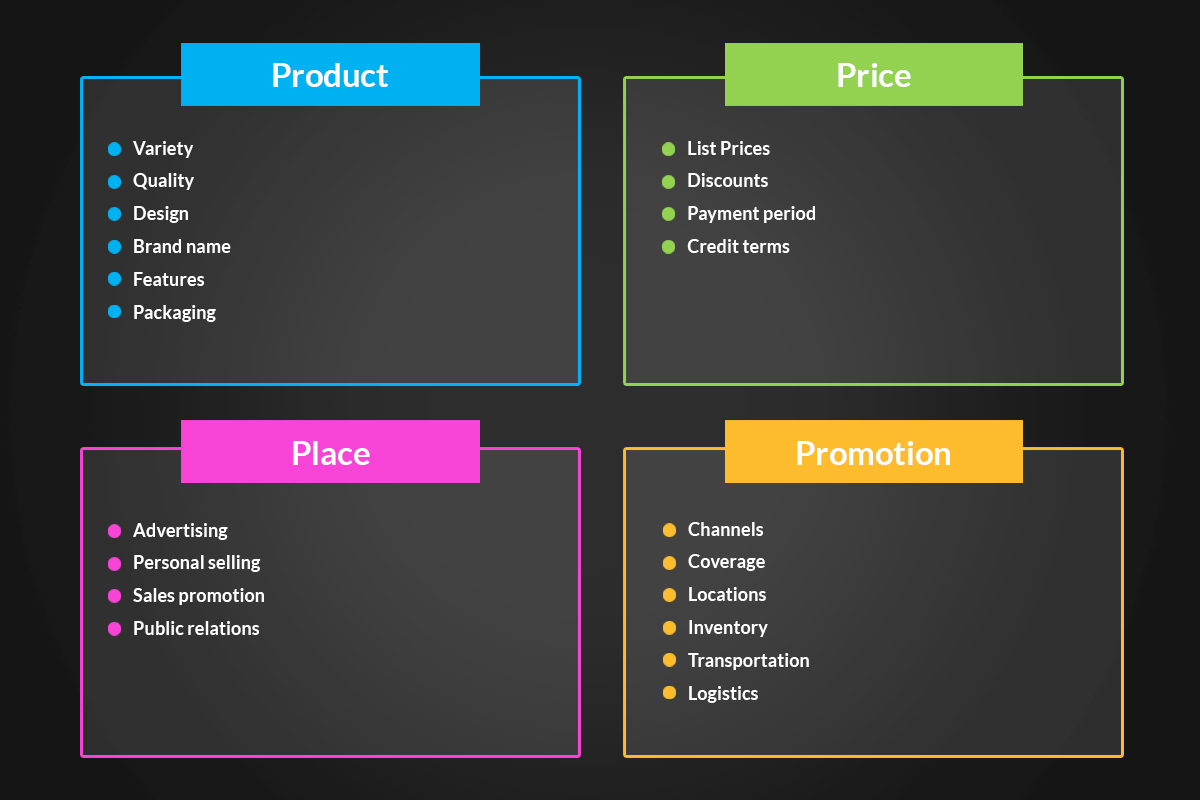
E-commerce has changed the nature of business drastically. In a world of Amazon, eBay, and all other different retailer giants, being a small retailer business is a big feat. Small businesses make up 99.9% of all U.S firms resulting in no shortage of competition. At the same time, in giant eCommerce companies, sales grow annually at a rapid pace. But one out of four small businesses lacks an online store with the prime opportunity of gaining a competitive edge through e-commerce development.

The global sales of E Commerce are 5695 today and are expected to reach 6542 billion by 2023
What Can Ecommerce Development Companies Do for Small Businesses?
A drastic impact has been felt by small businesses due to e-commerce. Different sectors and organizations have faced high competition from them. If so, how?
- Their products are offered at much lower/reasonable prices.
- Every type of product comes from a variety of brands. Therefore, you don’t have to move everywhere to find the best product for your budget and requirements.
- When you purchase products online, there is no time limit. Whenever and for how long you want to view the product, you can do so.
- With just a touch of your fingertips, you can place all orders. No need to go out and search for the products with hassle.

Small business e-commerce strategies
Taking care of your strategy and planning it carefully is essential to success in digital entrepreneurship. Start your small business with the five strategies below.
- Enhance the filtering of products with advanced features
Your customers will enjoy shopping with an advanced product search through eCommerce development, providing an easy shopping experience.
Using this system, your site visitors can find what they need in seconds.
Your products can be filtered easily by adding up to 250 tags with eCommerce development solutions like Shopify. You can show your shopper’s product choices based on color, design, size, and more, without having them manually. As a result, your user experience improves, which leads to a higher sales volume.
- Highlight new products
Putting your product’s features into words isn’t enough. Videos and images are usually much more effective ways to demonstrate your product’s capabilities.
Customers can quickly see how key features work and look with images. Most e-commerce development products, especially design-focused features, are particularly useful. Adding user-generated photos to your description will earn you bonus points.
Videos can be even more effective if they are created with more effort. Your product’s core features can be outlined in an explainer video or separate videos.
- Offering more payment options
By offering more alternative payment methods, you may be gaining more customers from your competitors if you don’t meet their demands. It will be difficult to retain a customer if their payment method of choice isn’t available because they know they can go somewhere else. It is better to become the store they come to after leaving another one, rather than being the one they leave for another.
- Discounts
A discount makes your customers feel good, so that’s an advantage. Coupons and savings offer to make people happier and more relaxed. Positive feelings could eventually be associated with your brand, which could prove to be beneficial over the long run.
According to a study by Max Planck Institute for Tax Law and Public Finance, discounting also decreases the likelihood that people compare your products to those from other companies. Using this technique of eCommerce development can help you gain new customers over your competition.
- Leverage social proof
A brand can use social proof as a powerful persuasion tool. It’s much better to get others to promote you than to market yourself. Social proof refers to the process where people assume that other people’s actions represent correct behavior and imitate them. Through social proof, marketers can pacify customers’ fears and boost conversion rates.
It is impossible to overstate the importance of building social proof. According to research, 92 % of consumers read product reviews before buying. The 12-times greater trustworthiness of product reviews over product descriptions and manufacturer sales copy talks even more about the power of product reviews.
It is not the companies selling the products that customers want proof from, but their peers and unbiased third parties. The next logical step in purchasing should be to purchase the goods or services from an eCommerce development website. Make sure the prospect makes a simple decision that is easy to understand and simple to implement.
What is Marketing Strategy?
Marketing is an organization’s plan for turning potential customers into paying clients. Generally, it contains a step-by-step description of how a company can achieve its objectives and goals. Marketing strategies usually consist of the following four factors. However, eCommerce developers understand the tactics of marketing and develop the website accordingly.
- Product
- Price
- Place
- Promotion

The four key elements of the marketing plan cover important information. In addition to describing the benefits of its product or service, a company may also describe how it will inform its customers about those products and services, as well as how it stands out from its competitors. Following an effective plan helps businesses attract their target audience and ensure that they are using their resources efficiently.
The best strategies to develop an e-commerce site for a small business
Choosing whether or not to start a new company can be one of the biggest life decisions you will make. About two-thirds of businesses with employees survive at least two years; half survive at least five years, says the Small Business Administration (SBA). 50 % of the business fails within 5 years only. But a business with eCommerce development strategies remains always ahead.
However, it is clear to get off to a strong start. To minimize risk and maximize chances for success, there are several serious considerations to make before leaping.
Financial Feasibility
The purpose of financial feasibility is to assess the study’s financial feasibility. During this process, start-up costs, operating expenses, cash flow, and future performance are evaluated to determine the economic viability of a proposed venture.
An evaluation of the financial feasibility of a project determines whether it is financially feasible and gives an estimate of the return on investment.
Market Feasibility
A real-world market’s reaction to a particular development is what market feasibility is all about.
Knowing how the market will respond to a particular project/product requires in-depth knowledge and analysis of the real estate market. In addition, market feasibility involves identifying the potential threats to the target market and how to overcome them.
Legal and Risk Management Issues
An organization’s risk management process identifies, assesses, and controls threats to its earnings and capital. Risks can be attributed to a variety of factors, including financial uncertainty, legal liabilities, technology issues, strategic management errors, accidents, and natural disasters.
Successful management of risk programs helps an organization consider the risks; it faces. Risk management help to examine the relationship between cascading impact and risks they could have on an organization’s strategic goals.
Conclusion
E-commerce is gaining ground as the future becomes brighter. Since COVID-19 threatens brick-and-mortar stores, people are turning to online shopping instead.
Make sure to follow the above strategies to grow your sales and gain an even bigger piece of the pie. You can take assistance from the best ecommerce development company for your start-up so that you can compete in the market without hesitation.
 +44 141 628 8980
+44 141 628 8980
 (786) 269-2247
(786) 269-2247
 +61 872007153
+61 872007153
 +91 8900027268 (Sales only)
+91 8900027268 (Sales only)







